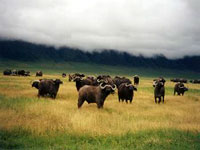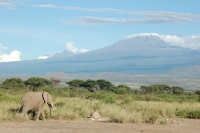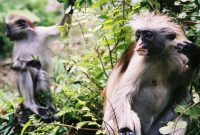National Parks and Reserves Travel Guide
Tanzania boasts some of the world's most famous natural attractions, most of which are enshrined in its famous national parks. The country is undoubtedly a premier wildlife safari destination, and the Serengeti alone would be enough to skyrocket its reputation for game viewing. The majestic Mount Kilimanjaro, the highest freestanding mountain in the world, is also a huge draw card for ambitious hikers.
Almost a quarter of Tanzania is protected within a park or reserve and, of these, most tourists visit the top three in the north: the plains of the Serengeti, famous for the annual migration of about two million wildebeest; the adjacent Ngorongoro Conservation Area, home to the magnificent Ngorongoro Crater; and Mount Kilimanjaro National Park, which encompasses Africa's highest mountain. Other attractions, including the massive Selous Game Reserve in the south, can be difficult or expensive to get to, and are less visited as a result, but they are still very worthwhile.
The word 'safari' has its origins in Tanzania, with the Kiswahili word meaning 'journey'. There are unlimited safari options available from the many tour operators plying their trade in the region. It's possible to arrange both luxury and budget itineraries and generally Tanzanian wildlife safaris are extremely highly rated.
A journey by vehicle, foot, horseback, or hot air balloon into prime game-viewing country is an experience not to be missed. The attractive town of Arusha is the main gateway to the parks and reserves in the north, and is the best place from which to arrange a safari.
The best time of year to go on safari in Tanzania is generally between June and October, during the dry season, but there's some variation depending on region, national park and desired activities.
Things to do in National Parks and Reserves
The Serengeti National Park, Ngorongoro Conservation Area, and Mount Kilimanjaro National Park are all well known to foreigners as prime safari destinations, but Tanzania has much to offer beyond this renowned Northern Safari Circuit.
Many lesser-known gems invite repeat visits to the country for nature and animal lovers. There are in fact 15 national parks in Tanzania, and a further 15 game reserves and protected wilderness areas, ensuring that vast swathes of this beautiful country remain in pristine natural condition.
For those seeking out chimpanzees rather than the Big Five, the Gombe Stream and Mahale Mountains National Parks that border Lake Tanganyika in western and central Tanzania are the best bet.
Ruaha National Park, Tanzania's largest, is home to a large population of elephants and is a good option for adventurers wanting to get off the beaten track and experience a true, rugged wilderness seemingly devoid of people.
The Selous Game Reserve of southern Tanzania is also vast and also feels delightfully empty of humankind, offering a large variety of game, including impressive numbers of the seriously endangered wild dog.
Hikers who prioritise landscape over wildlife would do well to visit the biodiverse paradise of Udzungwa Mountains National Park, in central Tanzania, which promises glorious trekking opportunities.
Those spending time in Zanzibar will find the Jozani-Chwaka Bay National Park a wonderful place for bird and butterfly viewing, not to mention seeking out the odd-looking red colobus monkeys that call the island home.
Serengeti National Park
Meaning 'endless plains' in the Masai language, the Serengeti is Tanzania's oldest park and one of the world's best wildlife refuges, continuous with Kenya's Masai Mara Game Reserve to the north. The open plains are home to an estimated three million large mammals that are involved in seasonal migration, and have the largest concentration of wildlife in the world if the figure includes the population of birds and smaller animals. The Serengeti is famous for the Great Migration, possibly the most astounding occurrence in the animal kingdom that's known to humankind. During this time, millions of hoofed animals, predominantly wildebeest, form one massive herd and leave the dry plains of Tanzania in search of greener grazing and water to the north. Bringing up the rear of the procession are the weak, the young, and the crippled, followed closely by large numbers of vigilant predators, including lions, cheetahs, hyenas, and wild dogs.

Ngorongoro Conservation Area
Rising above the plains of the Serengeti, the Ngorongoro Conservation Area is a vast, UNESCO-listed protected area that includes the important archaeological site of Olduvai Gorge and its main attraction, the Ngorongoro Crater. Once the site of an active volcano, the crater was formed about two million years ago when its cone collapsed on itself. Today the crater floor, supplied with permanent water and ringed with towering forested sides, serves as a natural cradle for an astounding abundance of wildlife. With an incredible width of 12 miles (20km) and a depth of 2,001ft (610m), the crater is the largest caldera in the world and is home to tens of thousands of animals, including rhino, buffalo, and large herds of zebra and wildebeest. There are also dense concentrations of predators attracted by the large variety of grazers, and prides of lion with magnificent black-maned males are one of the highlights.

Mount Kilimanjaro National Park
Rising 19,341ft (5,895m) above the African plains, the magnificent solitary peak of Mount Kilimanjaro is the dominant feature of this national park. The lush rainforest on its lower slopes is home to a number of animals including elephant, buffalo, rhino, monkey, and leopard. Its dormant volcano is remarkable in many ways, not only for its snow-covered peaks and glaciers rising out of a humid equatorial jungle, but also because it's the highest freestanding mountain in the world, a huge cone unattached to a mountain range, and Africa's highest peak. Its magnetism has attracted researchers, mountaineers, and adventurers for years. It's the only mountain of its size that can be scaled by inexperienced hikers, although altitude sickness is common and can be fatal. There are six different routes of varying degrees of difficulty, but the easiest and most popular way to reach the summit is on the Marangu Trail, which takes about five days, with nights spent in huts along the way.

Udzungwa Mountains National Park
Said to be the most biodiverse national park in Tanzania, Udzungwa Mountains National Park is less a magnet for game viewing than for hiking. A network of forest trails crisscrosses the peaks and offers treks to hidden waterfalls and majestic vistas. A popular hike is the half-day trip to Sanje Waterfall, while the two-day hike along Mwanihana Trail provides panoramic views of the surrounding valleys. Visitors can also hike to cultural and historical sites such as the Mwanaruvele and Magombereka Caves. While Udzungwa Mountains National Park isn't known for its game, there are still plenty of exotic animals to spot, including birds, mammals, reptiles, amphibians, butterfly, and other creatures. The Iringa Red Colobus Monkey, and the Sanje-Crested Mangebay, both found only in Tanzania, can be spotted in the park.
Tanzania travel info
Electricity
The electrical current 230 volts, 50Hz. Rectangular or round three-pin plugs are used.
Language
Swahili and English are the official languages, though several indigenous languages are also spoken.
Money
The official currency is the Tanzanian shilling (TZS), which is divided into 100 cents. The tourism industry prices everything in US dollars and this is the preferred unit of currency for hotels, lodges, resorts, safaris, national parks and attractions, guides and tours, as well as high-end restaurants. Money can be exchanged in larger towns; foreign exchange bureaux may offer a better rate of exchange than banks.
Major cities have ATMs that accept foreign debit cards and issue Tanzanian shillings, though they sometimes break down or run out of money. To minimise the risk of card cloning, travellers should use ATMs located in banks, shops, hotels and shopping centres rather than on the street.
Major lodges, some hotels and travel agents in urban areas accept credit cards, but these shouldn't be relied on and can incur a surcharge. International digital wallet services such as Apple Pay and Google Pay are still relatively limited in their availability, especially for everyday transactions.
Tipping
Waiters in the better restaurants should be tipped around 10 percent; guides, porters and cooks in the wildlife parks and on safari trips usually receive tips as well. The amount is discretionary according to the standard of service and the number of people in the travelling party.
Health
Visitors should consider vaccinations for hepatitis A, hepatitis B, typhoid, and polio, and proof of yellow fever vaccination is required if visitors are coming from or have transited through an airport of a country where yellow fever occurs. There's a risk of malaria all year and outbreaks of Rift Valley Fever occur; travellers should take precautions to avoid mosquito bites and take malaria medication.
Food prepared by unlicensed vendors should be avoided, as meat and milk products from animals may not have been cooked thoroughly. Sleeping sickness is a risk in the game parks, including the Serengeti, and visitors should take precautions against bites by tsetse flies.
There's a high prevalence of HIV/Aids; cholera outbreaks are common throughout the country and visitors are advised to drink bottled or sterilised water only. Travellers climbing Mount Kilimanjaro are at risk for altitude sickness.
Medical services are available in Dar-es-Salaam and other main towns, but facilities and supplies are limited even in cities and often non-existent in rural areas. Visitors with particular requirements should take their own medicines. Comprehensive travel insurance is advised.
Safety
Most visits to Tanzania are trouble free, but violent and armed crime does exist. Travellers are sometimes the victims of mugging and bag snatching (especially by passing cars or motorbikes), and armed robbery and burglary rates have increased throughout the country. Travellers should avoid walking and cycling at night, and should walk towards the traffic so they can see the vehicles approaching. They should also avoid carrying large amounts of cash or other valuables, and leave their passport in the hotel safe.
As in other East African countries, there's some threat of terrorism in Tanzania, and visitors should be cautious in public places and at tourist sites. The areas bordering Burundi, the Democratic Republic of Congo and with Mozambique in the Mtwara region should also be avoided.
Road accidents are common due to poor road and vehicle conditions, violation of traffic regulations and exhaustion among long-distance drivers. There have also been a number of ferry accidents in Tanzania in recent years. Travellers should take precautions, such as staying away from buses or ferries that seem overloaded or in poor condition.
Local customs
Tanzanians are known to be friendly and are generally welcoming, but travellers should be sensitive to local cultural mores. Drunkenness is frowned upon and Tanzanians feel strongly about showing respect for their elders.
Visitors to Zanzibar should be aware that it's a predominantly Muslim region and visitors should dress modestly and respectfully. Beachwear is fine on the beach or around a hotel pool, but not acceptable elsewhere. Topless sunbathing is a criminal offence. Some tourists buy a local sarong, called a kanga, which can be used to cover shoulders when needed, or otherwise be used as a towel.
Smoking in public places is illegal; tourists should be especially careful during Ramadan, when public drinking, smoking and even eating in public should be avoided. Homosexuality is illegal.
Doing business
Although Tanzanians come across as relaxed and friendly, it's important to observe certain formalities, especially with greetings. It's advisable to learn a few Swahili phrases when greeting, followed by a handshake.
Women and men rarely shake hands in Swahili culture; however, if the woman extends her hand, the man is obliged to take it. Tanzanians are to be addressed as Mr, Mrs, and Ms, followed by the family name.
Business dress is seldom very formal but lightweight suits are recommended for formal occasions. Business hours are similar to Western countries, but a longer lunch break is taken during the hotter months, and business continues later in the evening from Monday to Friday.
Duty free
Travellers to Tanzania do not have to pay duty on 250g tobacco, 200 cigarettes or 50 cigars, and one litre of whisky and liquors or two litres of wine.
Communications
The international country dialling code for Tanzania, as well as Zanzibar, is +255. There's good mobile phone coverage in main cities and towns, while rural areas may have limited coverage. There are international roaming agreements with most international operators. WiFi is available in main towns and resorts; visitors can purchase local prepaid SIM cards for unlocked phones or use eSIMs if their cellular providers support it on their networks.
Passport & Visa
All visitors to Tanzania require proof of sufficient funds and should hold documentation for their return or onward journey. Passports should be valid for at least six months from date of entry. Most visitors entering will require a visa as well. Those arriving from an infected country must hold a yellow fever vaccination certificate. It's highly recommended that travellers' passports have at least six months' validity remaining after the intended date of departure from their travel destination. Immigration officials often apply different rules to those stated by travel agents and official sources.
Entry requirements
US passports must be valid for six months from the date of entry. Travellers will need to apply for an eVisa before visiting Tanzania.
UK passports must be valid for six months from the date of entry. Travellers will need to apply for an eVisa before visiting Tanzania.
Canadian passports must be valid for six months from the date of entry. Travellers will need to apply for an eVisa before visiting Tanzania.
Australian passports must be valid for six months from the date of entry. Travellers will need to apply for an eVisa before visiting Tanzania.
South Africans do not require a visa if intending to stay for a maximum of up to 90 days, provided that the passport is valid for six months from date of entry.
Irish passports must be valid for six months from the date of entry. Travellers will need to apply for an eVisa before visiting Tanzania.
New Zealand passports must be valid for six months from the date of entry. Travellers will need to apply for an eVisa before visiting Tanzania.
Useful contacts
Tanzanian Tourist Office: www.tanzaniatourism.go.tz
112 (General)


